Title I Reading Multi Criteria Selection Form
- Methodology
- Open Access
- Published:
Application of an integrated multi-criteria decision making AHP-TOPSIS methodology for ETL software selection
SpringerPlus volume 5, Article number:263 (2016) Cite this article
Abstract
Actually, a gear up of ETL software (Extract, Transform and Load) is available to constitute a major investment market. Each ETL uses its own techniques for extracting, transforming and loading data into data warehouse, which makes the task of evaluating ETL software very difficult. However, choosing the correct software of ETL is critical to the success or failure of whatever Business Intelligence project. As there are many impacting factors in the selection of ETL software, the same procedure is considered as a complex multi-criteria decision making (MCDM) trouble. In this study, an awarding of decision-making methodology that employs the ii well-known MCDM techniques, namely Analytic Hierarchy Procedure (AHP) and Technique for Guild Preference by Similarity to Platonic Solution (TOPSIS) methods is designed. In this respect, the aim of using AHP is to analyze the construction of the ETL software selection problem and obtain weights of the selected criteria. And then, TOPSIS technique is used to calculate the alternatives' ratings. An example is given to illustrate the proposed methodology. Finally, a software prototype for demonstrating both methods is implemented.
Background
Concern Intelligence (BI) is a field of data systems architecture. Information technology allows implementing the ways to collect, transform and restore information to help determination-makers in enterprises. The center of BI is based on information warehouses powered by ETL, which is generally a role of BI and is ordinarily the starting point for each project. With the evolution of the apply of BI, ETL becomes a critical gene affecting the success of a BI projection. In the surveys conducted to decide important questions touching decision-makers and designers of BI projects (Simitsis et al. 2009; Wyatt et al. 2009), ETL software has been ranked among the highest priorities (Kimball and Caserta 2004).
One of the important and initial activities of a BI project is the selection of the nearly appropriate ETL software. In other words, the chosen software must be in accordance with the organizational goals and has to maximize the benefits of the organization. So, choosing ETL software is a wise choice that limits the costs and risks associated with projects.
Moreover, conclusion making in the field of Business concern Intelligence software pick such as ETL, has go more complex due to a large number of software products in the marketplace. For choosing the nigh appropriate software, in this regard, ISO/IEC 9126-1 (2001) has established six quality characteristics for whatever software products: Functionality, Reliability, Usability, Efficiency, and Maintainability.
Due to the multi-criteria nature for selecting ETL software, multi-criteria decision making (MCDM) has been institute to be a powerful and suitable technique to solve this blazon of option problems. The belittling model integrated with AHP (Analytical Hierarchy Process) method and TOPSIS (Technique for Order Preference by Similarity to Ideal Solution) will aid to determine the correct judgment in ETL software selection based on decision-makers' specific requirements. This newspaper proposes an integrated AHP-TOPSIS model considering both qualitative and quantitative factors. In this respect, AHP tin be very useful in involving several determination-makers with multiple conflicting criteria to arrive at a consensus in the conclusion making process. On the other side, TOPSIS technique is used to calculate the alternatives ratings.
The residual of the paper is organized as follows. The second section gives a brief overview of existing methods and studies for software selection. In section 3, the methods used in the proposed determination-making methodology are presented. The proposed methodology is concisely explained in the fourth section. As regards the next department, for better understanding of the methodology, an empirical study is illustrated, and sensitivity analysis is highlighted. The implementation of a software epitome for demonstrating the proposed methodology is given in section six. Finally, conclusions and further inquiry are offered in the final department.
Software pick review
The problem of the pick of BI tools is i of the strategic decisions that accept a pregnant touch on business concern functioning. With the evolution of decision support systems, the making decision becomes increasingly disquisitional. However, ETL software option is considered to be a highly important enquiry issue in BI (Simitsis et al. 2009), just information technology has non nonetheless received much attention in inquiry as further as research on this subject is necessary. One of the main motivations of this research is the absence of evidence in the literature that such papers do not utilize a methodological approach-such as AHP-TOPSIS-for evaluating and selecting ETL software.
The state of the art is very rich by various methods suggested for the pick problem (Amiri 2010). All the methods tin can be classified in iv different categories: MCDM (multi-criteria conclusion making) is the first category which contains unlike methods such as: AHP, ANP (Analytical Network Procedure), PROMETHEE (preference ranking organization method for enrichment evaluations), ELECTRE (ELimination and Option Expressing Reality) TOPSIS etc. Wei et al. (2005) used the AHP method to identify priority in selecting ERP Arrangement. Similarly, Yigit et al. (2014) adult an interactive model using AHP to facilitate the pick of Spider web-based learning object software. Also, Göztepe (2012) applied ANP method to appraise and select the best Operating organisation with regard to organizational factors and strategic functioning metrics. Behzadian et al. (2012) asserted a TOPSIS based model for multi criteria decision making in another study.
The second category concerns mathematical programming methods. Information Envelopment Assay (DEA) and linear programming methods can be included in this category. Lengacher and Cammarata (2012) suggested a DEA model to evaluate and select Portfolio. As another model, Liu (2012) developed a weighted linear programming method for the site selection of distribution center problem.
Artificial Intelligence methods, equally a third category, contain genetic algorithm, artificial neural network (ANN) and data mining methods. In this context, Guo et al. (2011) presented a Genetic Algorithm for Optimized Characteristic Selection with Resources Constraints in Software Product Lines. Similarly, Flintsch et al. (1998) suggested an artificial neural network model for project selection level pavement management organisation.
The last category is concerned with integrated approaches. In that location are so many studies about integrated methods for software selection problem in the literature. Onder and Dag (2013), proposed an approach based on AHP and improved TOPSIS for the supplier pick problem. In another study, Kuei-Yang Wu (2010) proposed an integrated approach of Fuzzy AHP for Amalgam Evaluation Model for Sustainable Development in Community Wellness and Welfare. Eldrandaly and Naguib (2013) from another scale, proposed an integrated approach of expert organization and AHP to select the best GIS software. Similarly, Zaidan et al. (2015) presented an approach based on integrated AHP and TOPSIS to select the optimal open-source EMR software packages.
In this written report, we choose an integrated approach which combines AHP and TOPSIS methods. AHP method is an excellent MCDM technique equally information technology provides a structure and hierarchy method for synthesizing software selection issues which is used to calculate the weight of selected criteria (Lin et al. 2007), and TOPSIS technique is employed to rank the alternative software based on their overall functioning.
The proposed integrated methodology has many advantages compared to the previously proposed techniques in the literature as follows: (i) it is suitable for the evaluation and selection of ETL software to consider the determination-makers' preferences depending on their knowledge and experiences; (ii) the weights of multiple and conflicting criteria are obtained by using pair-wise comparisons according to preferences of the decision-makers; and (iii) the global ranking of the software alternatives are provided.
Multi-criteria decision-making methods
Analytical bureaucracy process method (AHP)
AHP is a multi-criteria decision making method that was proposed in the 1970s by Saaty. It has been used extensively for analyzing and structuring circuitous decision problems. The decision problem is first decomposed into different criteria (Dagdeviren et al. 2009). The AHP method can be used to assist decision-makers to calculate the weight for each criterion past using pair-wise comparison judgments (Liberatore and Nydick 1997; Yoo and Choi 2006; Panda et al. 2014).
AHP technique is a process that consists of the following steps (Saaty and Vargas 2001; Saaty 2008):
-
Step one: Structure the decision hierarchy taking into account the goal of the study and decide the criteria and sub-criteria.
-
Step 2: Found a set of all judgments in the comparing matrix in which the fix of elements is compared to itself by using the fundamental scale of pair-wise comparison shown in Tabular array i.
Table 1 Calibration of pair-wise comparison for AHP -
Step 3: Decide the relative importance of factors by calculating the corresponding Eigenvectors to the maximum Eigen values of comparing.
-
Step 4: Verify the consistency of judgments across the Consistency Alphabetize (CI) and the Consistency Ratio (CR).
$$CI = \frac{\lambda_{\rm max} - northward}{n - 1}$$
(1)
where λmax is the Eigen value corresponding to the matrix of pair-wise comparisons and north is the number of elements being compared.
Consistency ratio (CR) is divers by:
$$CR = \frac{CI}{RCI}$$
(ii)
where, (RCI) is a random consistency index defined in Table 2.
A value of CR less than 0.i is by and large acceptable; otherwise the pair-wise comparisons should be revised to reduce incoherence.
Technique for social club preference by similarity to ideal solution (TOPSIS)
TOPSIS (Technique for Club Preference by Similarity to Ideal Solution) method was developed by Hwang, and Yoon (1981), for solving multiple criteria conclusion making (MCDM) problems based upon the concept that the chosen alternative should have the shortest distance to the positive ideal solution (A*) and the longest distance from the negative ideal solution (A−). For instance, the positive ideal solution maximizes the functionality and minimizes the cost, whereas the negative ideal solution maximizes the cost and minimizes the functionality. In the process of TOPSIS, the performance ratings and the weights of the criteria are given as exact values (Lengacher and Cammarata 2012). Recently, several interesting studies have focused on the TOPSIS technique and practical it in many fields, including supplier pick, tourism destination evaluation, fiscal performance evaluation, location selection, company evaluation, and ranking the carrier alternatives. Examples of these studies can exist found in the literature such as ERP software selection (Huiqun and Guang 2012), customer-driven production design process (Lin et al. 2008), open-source EMR software packages (Zaidan et al. 2015). The steps of TOPSIS model are as follows (Tsaur 2011; Ding 2012):
-
Footstep i: Plant a decision matrix for the ranking.
-
Stride ii: Normalize the decision matrix using the following equation.
$$east' = \left[ {\frac{{g_{j} (a_{i} )}}{{\sqrt {\sum\nolimits_{i = i}^{m} {\left[ {g_{i} (a_{i} )} \right]^{2} } } }}} \right]; \, \quad {\text{i}} = 1, \, 2,\ldots,{\text{ m}};{\text{ and j}} = one,ii, \ldots, {\text{ n}}$$
(3)
where gi is deterministic value of alternative i for criterion j.
-
Footstep 3: Calculate the weighted normalized decision matrix past multiplying the normalized decision matrix with its associated weights every bit:
$$east^{*}_{ij} = \pi_{j} \times e^{\prime}_{ij} ;\quad {\text{ i}} = 1,{ 2},\ldots,{ k};{\text{ and }}\,\, {\text{j}} = 1, two,\ldots,{\text{ due north}}$$
(4)
where πj is the weight of jth criterion.
-
Step 4: Identify the positive platonic solution (A*) and negative platonic solution (A −).
$$\begin{aligned} &{\text{Positive}}{:} \\ &A^{*} = \left\{ {e_{j}^{*} , j = 1, 2, \ldots, northward} \right\} = \left\{ {e_{ 1}^{*} , e_{ 2}^{*} ,\ldots, e_{n}^{*} .} \correct\};e_{j}^{*} = Max_{i} \left\{ {e_{ij}^{''} } \right\} \\ &A^{*} - = \{ Min_{i} .e_{ij}^{*} ,\,\, i = 1, \ldots, m; \,\, and\,\, j = 1,\ldots, n\} \\ \end{aligned}$$
(five)
$$\brainstorm{aligned} {\text{Negative}}{:} \hfill \\ A - =& \left\{Min_{i}\, {e_{ij}^{''} \left. {,\quad i = 1,\ldots,m;and \, j = 1,\ldots, n}\right\}} \right.;\quad e_{j^*} = Min_{i} \{ e_{ij}^{''} \} \hfill \\ A - =& \left\{ {e_{j^*} ,j = 1,two,\ldots,n} \right\} = \{ e_{ane^*} ,e_{2^*}, \ldots, e_{n^*} \} \hfill \\ \end{aligned}$$
(6)
-
Step v: Decide the Euclidean distance of each alternative from the positive and negative platonic solutions.
$$D_{i}^{*} = \sqrt {\sum\limits_{j = 1}^{n} \left(e^{*}_{ij} - e^{*}_{j} \correct)^{2}} ,\quad {\text{ i}} = ane, 2, \ldots {\text{k}}$$
(seven)
$$D_{i}^{-} = \sqrt {\sum\limits_{j = ane}^{northward} \left( e^{*}_{ij} - e_{j^{*}} \right)^{ii}} ,\quad {\text{ i}} = 1, 2, \ldots {\text{chiliad}}$$
(viii)
-
Step six: Calculate the relative closeness coefficient of the i thursday alternative to platonic solution using the following equation:
$$C_{i}^{*} = \frac{{D_{i}^{ - } }}{{D_{i}^{*} + D_{i}^{ - } }}, \, \quad {\text{i}} = 1, ii, \ldots,{\text{m}}$$
(9)
With, 0 ≤ Ci* ≤ 1.
-
Step vii: Rank all alternatives based on decreasing values of Ci* and selecting the optimal 1.
Proposed integrated multi-criteria decision methodology
Over the last decades, many researchers accept devoted their endeavour to blueprint the best methodologies for determination-making. The proposed methodology is designed in such a way that makes the use of MCDM techniques as efficient equally possible. Two unlike techniques, namely AHP and TOPSIS, are combined in order to rank culling software according to criteria. The reason for using the well-known AHP technique is to construction the determination hierarchy of the problem. Finally, to rank the alternatives, i of the most efficient MCDM techniques such as TOPSIS is used.
Future, the principal steps of the proposed integrated methodology to be elaborated by decisions-makers for the ETL software option trouble are equally follows:
-
Step one: Ascertain criteria and sub-criteria that are most affecting in the ETL software selection problem.
-
Step two: Construct a hierarchy determination model for the problem.
-
Step 3: Determine the comparison matrix for each level (level of criteria and sub-criteria) past using AHP technique to obtain the local weight of each benchmark and sub-benchmark.
-
Step 4: Determine the global weight by normalizing the local weight.
-
Step 5: Use the TOPSIS technique to assess the alternatives where the most appropriate i can be easily selected.
-
Step 6: Select the best ETL software alternative.
Figure 1 illustrates the process of the proposed integrated methodology to evaluate and select the ETL software.
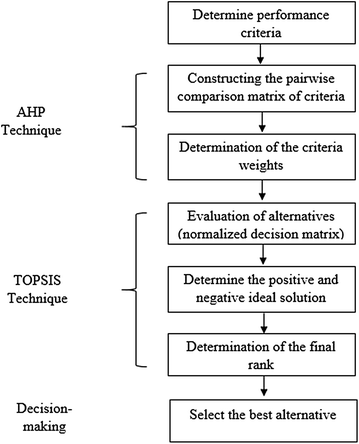
Proposed integrated methodology for ETL software choice trouble
Numerical illustration
In this department, to better understand of the proposed integrated methodology, an application is provided. The ETL software pick conclusion is very of import in long-term planning for any Business Intelligence project and is required due to diverse reasons, such as very expensive and open up-source software available in the market. And then each tool uses its own methodology for extracting, transforming, and loading of data. Hence, decision-makers should select the software for a new project that not simply performs well, but also is flexible enough to adapt hereafter changes in the project. The success or failure of whatsoever projection depends on the consideration of various criteria when selecting new ETL software, such equally: Functionality, Vendor, Usability, Cost, and Reliability (Wyatt et al. 2009; Kimball and Caserta 2004). In fact, conflicting criteria have high bear on on the software performance. In this case, choice of the suitable ETL software involves the consideration of multiple viable alternatives under multiple influential criteria. The trouble is so solved by using the proposed approach explained in Fig. one.
The integrated methodology is applied step past step to solve the ETL software selection problem for the BI project. Subsequently preliminary screening, five software: S1, S2, S3, S4 and S5, are chosen for further cess. Futurity, the master steps of the application of the proposed multi-criteria decision methodology for ETL software option is elaborated.
Furthermore, the identification of the criteria and the sub-criteria is the get-go footstep of the proposed methodology. Based on the literature review and contempo experiences of some specialists, in guild to identify some general decision-making attributes (criteria) for selecting the best ETL software, we propose five main criteria and 15 sub-criteria, which are the most prevalent and important in the selection of ETL software (Step i).
The five main criteria Functionality, Vendor, Usability, Cost, and Reliability, are further broken down into sub-criteria. Functionality is characterized past compatibility, scheduler, category, support BI (Business Intelligence) and security. Vendor is divided into technical capability, reputation and provides permanent services. Additionally, Usability is associated with ease of employ and completeness of the GUI (graphical user interface), while Cost criterion is cleaved downward into maintenance toll, consultant expense and toll. Reliability is finally divided into stability and recovery ability.
In the following, decision-makers follow the computational procedure of weights for selected criteria using AHP method, and so rank the alternatives with TOPSIS method. In the first pace of AHP technique, nosotros developed a hierarchy model of ETL software pick based on the criteria, sub-criteria, and alternatives (Step 2). As shown in Fig. ii, the highest and the lowest levels of the hierarchy announce the overall objective (selecting the most appropriate ETL software) and the software proposed (S1, S2, S3, S4, and S5) respectively. The five master criteria are included in the 2d level (Mousavi et al. 2012) and are farther broken down into sub-criteria in the 3rd level.
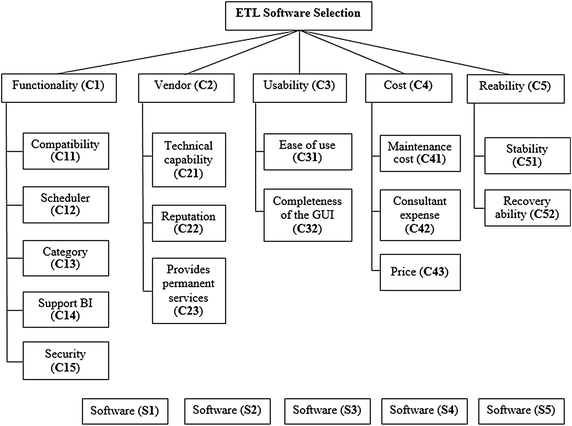
Hierarchy model of ETL software selection
In one case the hierarchy has been synthetic through the AHP technique, the next step is dedicated to obtain the weights of elements at each level of the hierarchy. A set of comparison matrices of all elements for each level of the hierarchy with respect to elements of the higher level are realized. The preferences of decision-makers are identified using Saaty scale (Saaty 2008) as shown in Tabular array 1.
The initial pair-wise comparison matrix for the primary criteria provided by decision makers is presented in Table 3. Moreover, the matrix of sub-criteria of the offset main criterion C1 (i.e., Functionality) presented by conclusion-makers is given in Table 4 (Step iii). Other comparing matrices of the sub-criteria are not shown hither. Only, Table 5 shows all weight vectors calculated past pair-wise comparisons as like to C1 in Table 4 (Pace iv). Ultimately, the consistency ratio (CR) of each pair-wise comparison judgment matrices is too shown beneath in each matrix. It tin exist seen that the CR of each matrix is less than 0.1.
At the concluding step, TOPSIS method is applied in order to rank the culling software. The global weights of each sub-benchmark which are calculated by AHP can be used as the input in TOPSIS method. So using the calibration in Table 1, the decision-makers are asked to evaluate the alternatives co-ordinate to each sub-criterion (Table 6) (Step 5.i). The second stride in TOPSIS technique is the normalizing of the amass ratings matrix, using the Eqs. (3), (4), as illustrated in Table 7 and thereafter, by using the Eqs. (5), (6), we can calculate the positive and negative ideal solutions (i.e., A* and A−) for the five alternatives (Footstep 5.2).
The ranking of alternative software are calculated by using the Eqs. (7), (8), and (ix). Table eight shows the evaluation results and terminal ranking of alternatives. Therefore, the best culling is the one with the shortest altitude to the positive ideal solution and with the longest altitude to the negative ideal solution. The proposed model results prove that software 3 is the best alternative with Ci value of 0.0084 (Step 6).
A sensitivity analysis is performed to analyze the two phases AHP and TOPSIS methodology proposed in this newspaper. For this reason, the criteria weights obtained from AHP are exchanged between 2 criteria while the others are abiding. In other words, the weight of the kickoff criterion C11 is exchanged with C12, C13 … and C52, sequentially, while the others are abiding. For each case, the A*, A− and the closeness coefficient (Ci) are calculated to brandish the new results and hence sixteen combinations (by adding the equal weight criterion) of the fifteen sub-criteria are analyzed (Gumus 2009). Then, the details of all the cases are summarized in Tabular array 9 and the closeness coefficient with ranking of the alternatives are shown both in Table 10 and graphically represented in Fig. iii.
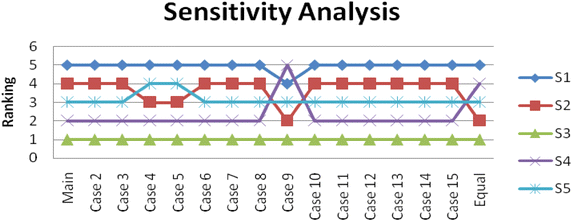
Sensitivity analyses under unlike criteria weights
From Table x and Fig. three, information technology tin be seen that the outset instance describes the original results of the integrated methodology. As well, out of sixteen cases, alternative software S3 has the highest score in all cases. Moreover, the results of the sensitivity analysis betoken that the alternatives' ranking has changed significantly according to equal weights of the criteria. Therefore, we can say that, based on the evaluations obtained, our determination making process is relatively insensitive to the criteria weights with S3 emerging as the winner of all the cases (Mousavi et al. 2012).
Proposed software
Equally tin exist easily proved, AHP and TOPSIS require many fourth dimension-consuming calculations, depending upon the number of the criteria, sub-criteria and alternatives that are necessary to make all calculations in order to attain the final solution (Duran 2011). Equally the number of criteria increases, the dimension of the trouble expands. This could pb to a great number of mathematical operations. Therefore, software aid may be very useful to automatically conduct out the methodology process. A software image for this methodology (AHP-TOPSIS) awarding is adult. This software is programmed past using JAVA on a PC platform. The operation sequence volition exist demonstrated in the post-obit paragraphs through the use of several screenshots.
Initially, the user must supply the criteria and sub-criteria chosen for the evaluation of the ETL software. The software image keeps a series of attributes that the user can select to perform the comparison analysis in a database. Moreover, the database contains a set up of generic criteria and sub-criteria labeled as ''criterion i'' and "sub-criterion j" where ''i and j'' stands for the number of a given benchmark and sub-criterion in social club. Then, the user must fill the pair-wise comparisons matrix for the criteria and sub-criteria. Figure 4 shows the Combo Box where the annotator can input the pair-wise comparisons among the software'southward criteria (using the scale of AHP). Once the comparison matrix is entirely filled with importance values, the ratio of consistency (CR) is computed automatically. In Fig. 5, the organization provides the Eigenvector of the five criteria and the fifteen sub-criteria according to the information inputted past the user.
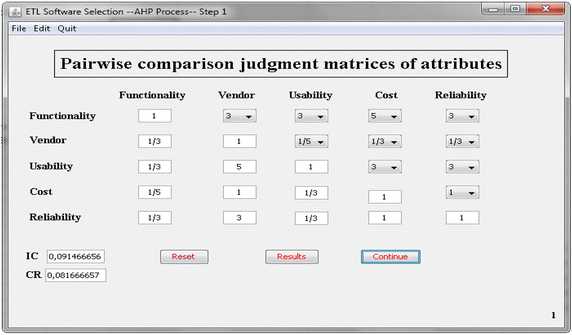
Screenshot of comparison matrix
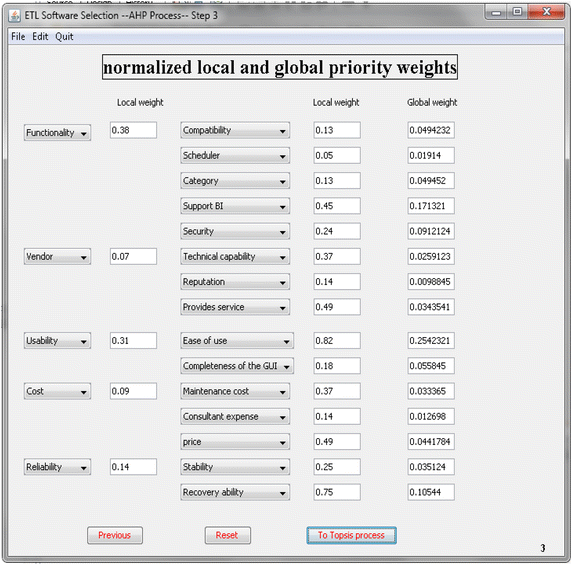
First stage analysis results
In the 2d part of the software, apropos the application of TOPSIS method, it is assumed that users must input the pair-wise comparisons of the five specific ETL software proposed. This task is made accordingly to each i of the considered sub-criteria (Fig. vi). In the next pace, the weighted normalized decision matrix is calculated, and the system must identify the positive A* and negative A− ideal solutions (Fig. vii).
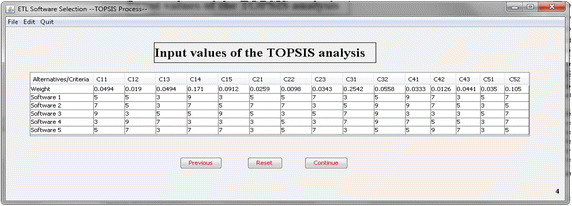
Input values of the TOPSIS analysis
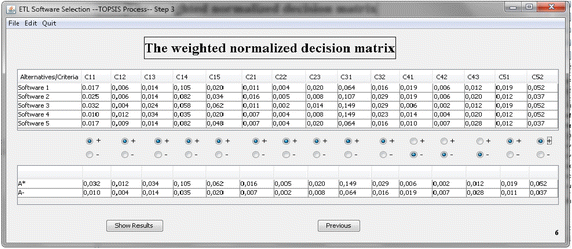
Weighted evaluations of the alternative software and adding of positive and negative ideal solutions
Finally, the software finds the scores of the ETL alternatives with respect to criteria and sub-criteria. It displays the results using the adding of the distance betwixt positive and negative ideal solutions. Therefore, the values and the priority scores for the ETL software alternatives are obtained. The ranked listing indicates that in this example the alternative software with the higher value of Ci has to be selected by the users every bit illustrated in Fig. 8.
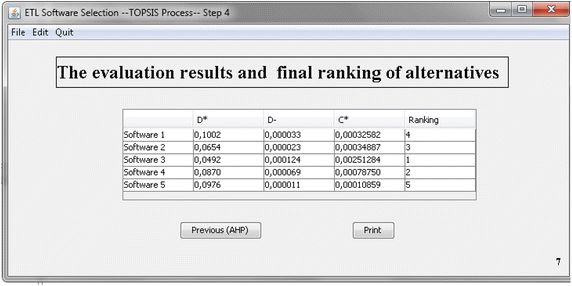
Final results of TOPSIS
Conclusion
Present, ETL software play an essential office in Business Intelligence (BI) projects, selecting suitable ETL software has become one of the well-nigh of import problems for starting a BI project. Our contribution presents an application of methodology based on a hybrid multi-criteria determination making process. The methodology consists of two techniques: analytical hierarchy process (AHP) and technique for order preference by similarity to ideal solution (TOPSIS). This methodology is tested by an example and information technology was found that it functions satisfactorily. Five software of ETL are chosen to demonstrate how the approach is practical and pb to the option of the software consistent with the maximization of the underlying techniques for all the decision-makers. Additionally, an AHP-TOPSIS methodology based software for selecting ETL software was proposed.
Although, the integrated methodology and the software prototype are introduced for ETL software selection problem, it can also be practical for any other software selection problem involving multiple and conflicting criteria. For farther studies, dissimilar techniques of MCDM, such equally ELECTRE, MACBETH, PROMETHEE, can be used and comparison of the results can be explored. Probably, the pair-wise comparing of the proposed methodology seems bereft and also imprecise to capture exactly the judgments of determination-makers, which is serious limitation. Regarding this point, the methodology can exist considered under the fuzzy environment.
References
-
Amiri MP (2010) Projection selection for oil-fields evolution by using the AHP and fuzzy TOPSIS methods. Skillful Syst Appl 37(9):6218–6224. doi:x.1016/j.eswa.2010.02.103
-
Behzadian Chiliad, Otaghsara SK, Yazdani M (2012) Ignatius J (2012) A state-of the-art survey of TOPSIS applications. Expert Syst Appl 39(17):13051–13069
-
Dağdeviren M, Yavuz S, Kılınç N (2009) Weapon selection using the AHP and TOPSIS methods nether fuzzy environment. Skilful Syst Appl 36(4):8143–8151
-
Ding J-F (2012) Using Fuzzy MCDM Model to Select Centre Managers for Global Shipping Carrier-based Logistics Service Providers. WSEAS Transactions On Systems, 11(3)
-
Duran O (2011) Computer-aided maintenance management systems pick based on a fuzzy AHP approach. Adv Eng Software 42(10):821–829
-
Eldrandaly K, Naguib S (2013) A Knowledge-Based Organization for GIS Software Option. Int Arab J Inf Technol 10(2):2013
-
Flintsch G, Zaniewski J, Delton J, Medina A (1998) Bogus Neural Network Based Projection Option Level Pavement Management Arrangement. In 4th International Briefing on Managing Pavements
-
Göztepe K (2012) A Report on Bone Selection Using ANP Based Choquet Integral in Terms of Cyber Threats. Int J Inf Security Sci. ane(ii)
-
Gumus AT (2009) Evaluation of hazardous waste transportation firms by using a two step fuzzy-AHP and TOPSIS methodology. Practiced Syst Appl 36(2):4067–4074. doi:10.1016/j.eswa.2008.03.013
-
Guo J, White J, Wang G, Li J, Wang Y (2011) A genetic algorithm for optimized feature selection with resource constraints in software product lines. J Syst Software 84(12):2208–2221
-
Huiqun Huang, Guang Sun (2012) ERP Software Selection Using The Rough Set And TPOSIS Methods Nether Fuzzy Environs. Int J Adv Inf Sci Serv Scis 4(3):111–118. doi:x.4156/aiss.vol4.issue3.15
-
Hwang CL, Yoon K (1981) Multiple attribute decision making: methods and applications. In Springer, Heidelberg
-
ISO/IEC 9126-1 (2001) Software Engineering-Product Quality—Part 1: Quality Model, International Arrangement for Standardization
-
Kimball R, Caserta J, (2004) The information warehouse ETL toolkit practical techniques for extracting, cleaning, befitting, and delivering data. In chapter two eISBN: 0-764-57923-i
-
Lengacher D, Cammarata C (2012) A 2-Phase Information Envelopment Analysis Model for Portfolio Selection". Adv Determination Sci 2012:1–nine
-
Liberatore MJ, Nydick RL (1997) Group Determination Making In Higher Education Using The Analytic Bureaucracy Process. Res Higher Educ 38(five):593–614
-
Lin HY, Hsu PY, Sheen GJ (2007) A fuzzy-based decision-making procedure for information warehouse system option. Expert Syst Appl 32(three):939–953
-
Lin MC, Wang CC, Chen MS, Chang CA (2008) Using AHP and TOPSIS approaches in customer-driven product pattern process. Comput Industry 59(1):17–31. doi:x.1016/j.compind.2007.05.013
-
Liu X (2012) The site option of distribution center based on linear programming transportation method. In Proceedings of the 10th Globe Congress on Intelligent Control and Automation
-
Mousavi Due south, Tavakkoli-Moghaddam MR, Heydar K, Ebrahimnejad Southward (2012) Multi-Criteria Decision Making for Establish Location Pick: an Integrated Delphi–AHP–PROMETHEE Methodology. Arab J Sci Eng 38(5):1255–1268
-
Onder E, Dag S (2013) Combining Belittling Hierarchy Process And TOPSIS Approaches For Supplier Selection In A Cable Company. J Business concern, Econ Finance 2(2):2013
-
Panda BN, Biswal BB, Deepak BBLV (2014) Integrated AHP and fuzzy TOPSIS Approach for the Selection of a Rapid Prototyping Process nether Multi-Criteria Perspective
-
Saaty TL (2008) Decision Making With The Analytic Bureaucracy Process. Int J Serv Sci 1(1):83
-
Saaty TL, Vargas LG (2001) Models, Methods, Concepts & Applications of the Analytic Hierarchy Process. International Serial in Operations Inquiry and Management Science
-
Simitsis A, Vassiliadis P, Dayal U, Karagiannis A, Tziovara V (2009) Benchmarking ETL Workflows. Lecture Notes in Information science. pp 199–220
-
Tsaur R-C (2011) Decision risk analysis for an interval TOPSIS method. Appl Maths Comput 218(8):4295–4304
-
Wei C-C, Chien C-F, Wang M-J (2005) An AHP-based arroyo to ERP organization choice. Int J Prod Econ 96(1):47–62
-
Wu K-Y (2010) Constructing Evaluation Model for Sustainable Development Community Health and Welfare. WSEAS Trans Syst 9(ten):1073–1085
-
Wyatt L, Caufield B, Politico D (2009) Principles for an ETL Benchmark. Lecture Notes in Computer science. pp 183–198
-
Yigit T, Isik AH, Ince Chiliad (2014) Spider web-based learning object selection software using analytical hierarchy process. IET Software 8(4):174–183. doi:x.1049/iet-sen.2013.0116
-
Yoo KE, Choi YC (2006) Analytic hierarchy process approach for identifying relative importance of factors to improve passenger security checks at airports. J Air Trans Manage 12(3):135–142
-
Zaidan AA, Zaidan BB, Al-Haiqi A, Kiah MLM, Hussain M, Abdulnabi Yard (2015) Evaluation and selection of open-source EMR software packages based on integrated AHP and TOPSIS. J Biomed Inform 53:390–404. doi:10.1016/j.jbi.2014.xi.012
Authors' contributions
TA and BO conceived the thought backside the proposed methodology and prepared the manuscripts. HM and AT carried out the study, developed the system and performed the experiments. All authors read and approved the concluding manuscript.
Acknowledgements
The authors wish to acknowledge the contributions of other members of the department of information science for their helpful discussions and the availability of all resource that have helped make this piece of work in the best conditions. They wish likewise to thank Mr. Redouane Boulguid for pointing out many English language corrections that pb to the improvement of the paper. The authors also like to thank the reviewers for their remarks and suggestions.
Competing interests
The authors declare that they have no competing interests.
Author information
Affiliations
Corresponding author
Rights and permissions
Open Access This article is distributed nether the terms of the Artistic Commons Attribution iv.0 International License (http://creativecommons.org/licenses/by/4.0/), which permits unrestricted use, distribution, and reproduction in whatsoever medium, provided you give appropriate credit to the original writer(s) and the source, provide a link to the Artistic Commons license, and betoken if changes were made.
Reprints and Permissions
Nearly this article
Cite this article
Hanine, M., Boutkhoum, O., Tikniouine, A. et al. Application of an integrated multi-criteria determination making AHP-TOPSIS methodology for ETL software choice. SpringerPlus 5, 263 (2016). https://doi.org/10.1186/s40064-016-1888-z
-
Received:
-
Accepted:
-
Published:
-
DOI : https://doi.org/ten.1186/s40064-016-1888-z
Keywords
- ETL
- ETL software selection problem
- Concern Intelligence
- MCDM (multi-criteria decision making)
- AHP (analytic hierarchy process)
- TOPSIS (technique for club preference by similarity to ideal solution)
Source: https://springerplus.springeropen.com/articles/10.1186/s40064-016-1888-z
Belum ada Komentar untuk "Title I Reading Multi Criteria Selection Form"
Posting Komentar